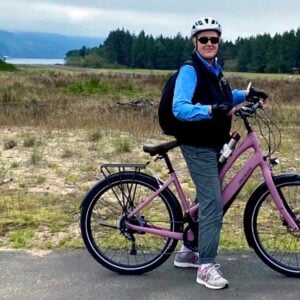I don’t usually cover news from other cities, but since road safety issues are a very hot topic in Portland right now, I thought I’d pass on some news from Grants Pass. Grants Pass is a town of about 25,000 just north of the California border.
According to Mark Lansing, a bicyclist and lawyer from Grants Pass who also writes a monthly column in Oregon Cycling Magazine, just last night their City Council adopted the following ordinance by a 6-1 vote:
“A person operating a motor vehicle on a public or private road shall maintain a zone of protection for a distance of not less than 3 feet between the motor vehicle and a bicycle, skateboard or scooter.”
Mark added that this happened as a result of a 5-year effort by the Josephine County Bikeways and Walkways Committee.
I know of one other city in Arizona where a similar law exists, perhaps there are others? Is it time for Portland to look into something like this?






Thanks for reading.
BikePortland has served this community with independent community journalism since 2005. We rely on subscriptions from readers like you to survive. Your financial support is vital in keeping this valuable resource alive and well.
Please subscribe today to strengthen and expand our work.
3 feet? That is a modest proposal. In many years of company mandated driver safety training the rule was 1 car length, about 12 feet, per 10 mph. Do they drive much slower in Grants Pass?
I’m so proud of Mark for getting this passed — he called me at the BTA about a year ago, and I hope I was able to help, but he deserves full credit. Here’s what citizen advocates can achieve…
Michael,
I believe the 3 foot zone is side-to-side, not front-to-rear. In other words, leave room when passing.
Excellent idea. My wife recently has started riding a Vespa and she percieves cars buzz right past her. This might be a good solution. I had the closest call ever a few weeks ago descending Corneilus Pass (I really didn’t mean to be on that road, just mistaken ended up there). I was buzzed so close by a semi, it blew me off the road and I almost went down. The problem will remain, unless there is law enforcement watching nothing will change.
The state of Utah has this three-foot rule also. It passed last year IIRC.
A similar measure was introduced in California this year. I don’t know the status of that bill in the state assembly.
This should be a statewide rule, adopted by the Legislature, not just a Grants Pass or Portland rule. It’s just common sense, and it will be as as or more useful on rural roads as on inner-city streets.
Great work, Grants Pass!!!
Maybe the BTA can fit this in somewhere after (in no particular order):
a. Tonquin Trail, connecting Wilsonville, Tualatin, & Sherwood
b. Highway 43 and Willamette Shoreline Trail
c. Fanno Creek Trail, connecting Portland, Beaverton, and Tigard
d. Low-traffic Suburban Routes
e. Oregon Center for Bicycling and Walking Research Institute
f. Beaverton Powerline trail from the Tualatin River to Forest Park
g. Launching a Tourism Center
h. West Linn to Oregon City crossing the Willamettte River
😉
I have been saying that this should be a statewide rule for years. I know that other states have this rule, and I was surprised that Oregon didn’t. Let’s make this statewide!
Go Portland!
Even if the rule were for in front vs beside you, a good way to judge the distance between you and the proceeding vehicle is the two seconds plus rule. As the vehicle in front passes a stationary object count 1001, 1002 (1003 “the plus” or more for bigger vehicles that take longer braking distances) and you should pass the stationary object at 1002. If you pass the stationary object at 1001 or less, you are too close react safely. I know this isn’t necessarily about bikes but education about other vehicles can make you a more knowledgeable biker.
Sweet justification for my 3-foot curb feelers!
It’s a good rule where there is the room. But for most streets in Portland, cars can barely pass as it is. I don’t mind being buzzed by cars as long as they’re not going much faster than I am.
I like this rule. I wonder what the fine is if car drivers violate it? ($275?)
This does give bicyclists a little more ammo if the actually do get hit by a passing car (provided they didn’t get killed). Skid marks and other evidence may show a less than 3 foot space prompting the issuance of a citation. This will make it easier for the bicyclist to recover medical and personal property costs.
I *absolutely* mind being buzzed by cars. There is plenty of room to pass if automobiles follow the law and drive at a safe distance until it is safe to pass.
Far too often, I’ve either been eeked past without so much as room to exhale, or the driver has given me all the room in the world, while whipping into the oncoming line of traffic with no regard for those driving toward him/her. The latter is always done with a prolonged gunning of the engine to make sure I know how I slowed that person down a whole four and one half seconds.
I’m in California and often ride in San Francisco. I’m not sure I’d want a 3-foot rule here — I *like* being able to squeeze past all the other traffic, and I’m willing to let cars squeeze past me if they’re traveling a little faster than me. No harm no foul as far as I’m concerned.
Faster moving traffic on suburban arterials is another story, but for congested urban traffic the 3-foot rule is not necessary and may be counterproductive.
I agree fully w/ Fritz.
I ride in between lanes downtown and don’t give cars 3ft, so i don’t expect them to give me 3 ft. I just expect door mirror clearance
In my opinion passing distance relates to speed and perhaps weight. Three feet is by no way sufficient when being passed by a semi at 60 mph. The BTA is looking into a concept like this for the state legislature, however current law “theoretically” protects cyclists. I don’t know if a 3′ passing rule is really the way to go.
The deterrent factor is important as well. This rule, especially with posting of signage, will do the most good by making motorists aware of the necessity of giving bicyclists more room on the road and the fact that they would be in violation for disobeying.
The recent deaths of Jane Higdon near Eugene and the McDaniel’s near Forest Grove should serve as ample proof that there is a need for laws requiring motorists to observe ample passing space between them and cyclists. Oregon is a wonderful place for cyclists: beautiful, condusive to healthy outdoor activities. Fortunately the majority of motorists are respectful of cyclists. But there are a few who appear not to mind scaring cyclists by driving unnecessarily close. I have had several incidents where drivers have passed within inches of my left arm. Once a log truck passed about a foot from my elbow. That driver didn’t slow down at all, and the blast of air from log truck blew me off the road. I was fortunate. As you may know there is a vacuum toward the back of fast moving vehicles and that can suck you toward it. Currently, it is not specifically agaisnt the law to drive close to a cyclist. Creating a 3-foot minimum law will heighten drivers’ awareness of the cyclists and the space we need… to live.
Scott, while a 3′ passing law may not make any practical difference in the enforcement of the law, it would at least offer a definitive minimum for explaining to motorists just how they need to pass cyclists. Not just “leave adequate room” or “be careful” when overtaking cyclists, but “3 feet or more – it’s the law”.
but you’re right, 3 feet from a 60 mph semi is the shortest 3 feet in the world…
News from California-
Great work on the passage of your local ordinance. I certainly know the pain of this fight.
Last year the California Legislature argued the 3 foot passing law for a brief minute. THe bill was killed immediately by the Highway Patrol and Truck Driver Unions. I represent the California Bicycle Coalition in the Capitol.
The bill has reappeared this year by the same author with no changes to the content. We are working hard now to find a way to deal with the opposition and ultimately change the behavior of motorists and the conditions on our roads. I would greatly appreciate your comments, tips, resources etc.
I am starting with a state search to find out who has an existing law and if it is working. We are also looking for partners or other interest groups that would care about such a law.
I think this cuts both ways. I am a relatively new cyclist, but I think there is a balance here. Bicycles should have at least a 3 foot buffer (5 feet seems more reasonable) but in zones which are wide enough for only one bike, there should be, as part of the same law, that bicyclists must ride single file. As both a motorist and cyclist I have seen many cyclists nearly “taunt” me and other drivers by riding in a dangerous, curvy are 3 or even 4 abreast. Only when we can recognize our part of the problem can we become part of the solution.
Dan @22:
I\’ve never \”taunted\” a motorist but I have no compunction about taking the lane as safety dictates, and as allowed by law (ORS 814.430). This applies especially on \”dangerous, curvy\” roads which may be too narrow to allow motorists to safely pass without crossing a double-yellow line.
FWIW the only time I\’ve ever seen a cyclist \”taunt\” a motorist in any way is during Critical Mass.